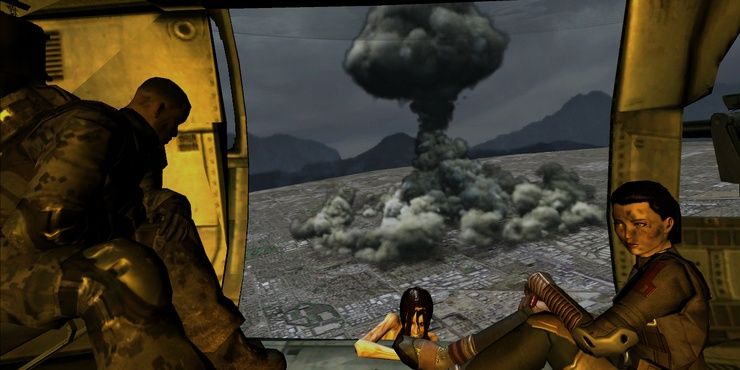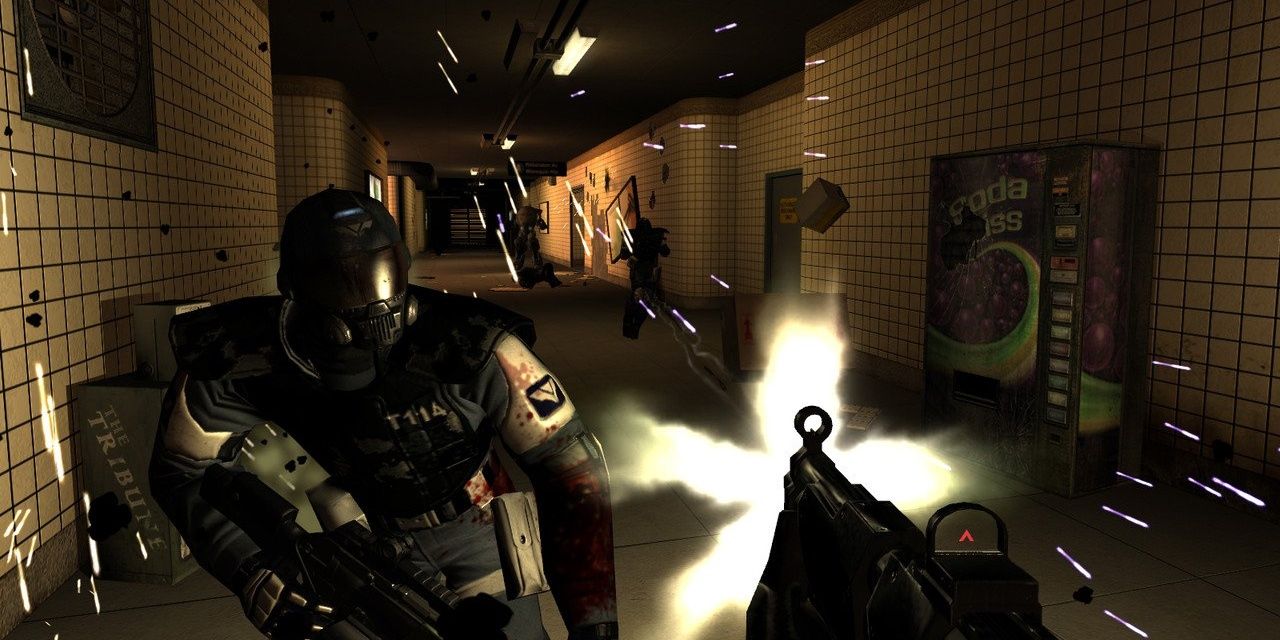F.E.A.R.’s Expansion Packs Were The Better Than The Main Series
At first glance, you wouldn’t think F.E.A.R. is one of the more complicated franchises out there. It’s just a trilogy of horror shooters, right? Some better, some definitely worse. Yet, due to IP rights wrangling, Monolith’s sprawling sci-fi horror epic about clone soldiers and psychic ghost girls became split down the middle.
On one side, you have the Monolith timeline which incorporates the brilliant first game, the abysmal F.E.A.R. 2: Project Origin, and ironically enjoyable F.E.A.R. 3 (or F.3.A.R., as it was originally styled). Monolith had the most direct influence over this timeline, even if they sat out the final entry.
Yet the less discussed timeline is a tale cut short, a rare case where a publisher’s desperate attempts to abscond away with an IP paid off for players. This is the Vivendi Timeline, made up of a series of expansions that pushed the original F.E.A.R. to its limits – all developed in the same fantastic gameplay as the first game, but with an ever-expanding gameplay sandbox.
It’s astounding to consider that two humble expansions would outdo a major AAA release. Monolith had more time, more money, refined tech, and a new publisher for Project Origin. At the time, it wasn’t even going by F.E.A.R. 2 due to Vivendi retaining the IP, with Project Origin serving as something of a soft-reboot/spiritual successor.
By contrast, the developer of the expansions, TimeGate Studios, was restricted to using an engine from 2005 – a very good engine, with impressive lighting and exceptional enemy AI for its day, but still fairly dated by comparison to what Monolith was working with at this point.
That’s what makes Extraction Point and Perseus Mandate so remarkable. TimeGate punched massively above their weight with these expansions, to the point that on a first playthrough, they’re practically a full-length game. Each pushes Monolith’s formula in intriguing directions, boasting impressive new mechanics, scares, and potential for the franchise to explore.
Extraction Point is a fairly straightforward elevator pitch. F.E.A.R. has a very weak ending that mostly sees you shooting slow-moving ghosts in less-than-creative arenas. The story had a weirdly happy ending other than a final jumpscare that lacked payoff. Extraction Point breaches through the adjoining door, shouting, “Sorry! Let’s do that again!” by starting its story moments after said jumpscare sends your helicopter crashing.
With your surviving allies scattered across the city, your desperate victory is ripped out from underneath you as your antagonist brother Paxton Fettel rises from the grave. “I know it doesn’t make sense. Not much does anymore. You killed me. I didn’t like that,” he declares before reanimating the clone army you’d fought so hard to shut down in the main game.
This could’ve been a cheap excuse, had the preceding game not already established that your and Paxton’s mother, Alma Wade, returned from death as well due to her psychic powers. Talk about bad blood, right? Well, there’s actually a unique angle here – Alma is reconsidering which son is her favorite.
Our hero, The Pointman, might not be able to command armies, but that’s okay because he effectively is one all on his own thanks to his incredible reflexes. So after an entire game of harassing and stalking you, Alma’s split personality starts contradicting itself.
The little girl persona begins to aid you, including outright slaughtering enemies waiting to ambush you on top of saving you from a burning church. The emaciated, hate-filled teenage Alma still constantly hunts your allies, driving the citizens of the city insane. She’s opened the gateway to unspeakable horrors, and she cares only for the safety of Pointman.
Not that it matters. Even after all your allies have been brutally murdered before your very eyes, you think that maybe you can escape. Surely, as the protagonist, you’ll endure a final onslaught as Paxton’s brotherly jealousy leads to every clone soldier heading your way. Brief fire support from one of your allies is a small comfort as everything descends into a hellish nightmare of luminal spaces and unrelenting assaults around every corner.
You fight your way through soldiers, mechs, remote turrets, horrific hallucinations, and even grab yourself a nifty laser gun, only to witness the whole city going up in flames. Paxton offers his brother one final prophecy of what lies ahead: “A war is coming, I’ve seen it in my dreams. Fires sweeping through the Earth, bodies in the streets, cities turned to dust. Retaliation…”
Now with most modern games, that’d be it, a teaser of what’s to come on a vague epilogue. Yet TimeGate actually had greater ambitions – enter Perseus Mandate.
If there’s one thing that’s obvious in hindsight, it’s that hinging the entire concept of F.E.A.R. around a single family drama was extremely limiting. The idea of a special government unit custom-built to address supernatural threats has boundless potential, which is precisely what Perseus Mandate aims to establish with a second F.E.A.R. team combating a parallel conspiracy to the Armacham Incident of the main game. In a way, it spookily mirrored reality, with Project Origin charging full speed ahead as Vivendi began reconsidering retaining the viability of the F.E.A.R. IP without Monolith’s stewardship. Despite solid critical reception, TimeGate’s first
This tangential nature is a blessing and a curse for Perseus Mandate. It actively pushes away from the traditional J-Horror vibe of its predecessors and trades it in for a X-Files feel. You go up against mysterious G-men, a PMC up to no good, and are left with hints that this is but one of several supernatural conspiracies unfolding under the government’s watch. Like Halloween III and Brightburn, Perseus Mandate establishes the potential for global horrors only barely kept in check. As Paxton warns, a war is coming, and Perseus Mandate could’ve easily been the start of that.
Instead, just like both those films, Perseus Mandate is left dangling. The entire expansion is a cliffhanger for a story we’ll never see the answer to because Vivendi seemingly expected two expandalones would be able to perform at the same level as a direct sequel. What makes this all the more tragic is how Perseus Mandate essentially is F.E.A.R. 2: Project Origin but better, at least where it counts.
What’s the key difference then? While it might be uglier than F.E.A.R. 2, Perseus Mandate is far better designed. Its combat emphasizes flanking maneuvers and verticality, and it’s perhaps the only F.E.A.R. game in existence with a great final boss. He can match your skills to an impressive degree, even your fancy kung-fu antics, demanding a strong grasp on the game’s mechanics.
There are no easily dispatched foes with exploding canisters on their backs or tedious quick-time events, levels are more than glorified hallways, and the music remains hauntingly ominous, keeping the slow burn mystery intact, rather than melodramatic. Your ammo for power weapons is sparser, calling for more tactful play. Everything that’s fumbled in Project Origin and F.E.A.R. 3 is nailed superbly across TimeGate’s expansions.
It’s enough to leave one curious as to where TimeGate could’ve taken the series. While their expansions aren’t flawless, they expand wonderfully on the great gameplay of F.E.A.R. rather than trying to reinvent the wheel. It’s fair to say the horror gaming landscape was expansive enough to permit two action-horror FPS series.
Despite their success with F.E.A.R. and their own series, Section 8, TimeGate would sadly fold not long after being wrangled into developing the campaign for Aliens: Colonial Marines. They were reportedly given less than nine months to develop the campaign from scratch. It’s a shame, really.
The one silver lining to all of this is that even if the story remains incomplete, it’s never been easier to experience F.E.A.R. at its best. A fresh re-release on GOG that bundles the original and its expansions is available now, ready to run on virtually any hardware. At the same time, the original game and the F.E.A.R. Files bundle are each backwards-compatible on Xbox, provided your model has a disk drive.
So what are you waiting for? Go forth, and karate-kick breach your way through a door to fight some demons and clone soldiers! I imagine for many, this’ll be their first time experiencing either expansion, and they’re well worth tracking down.




